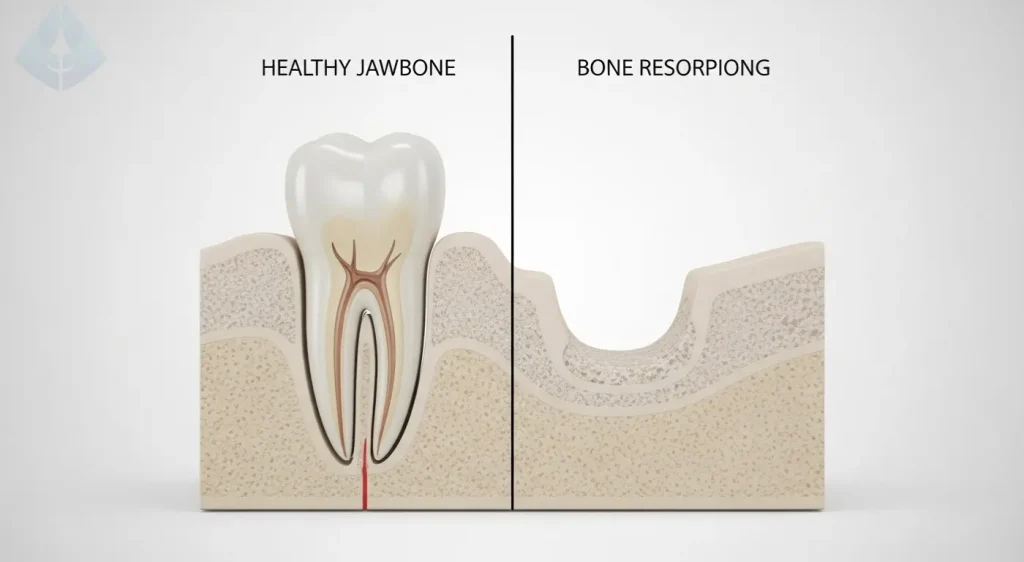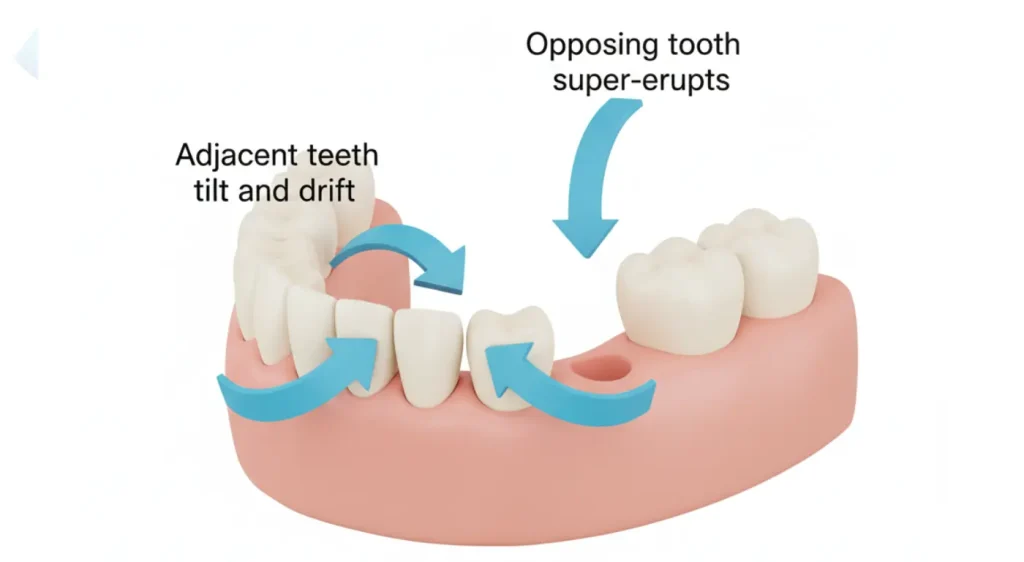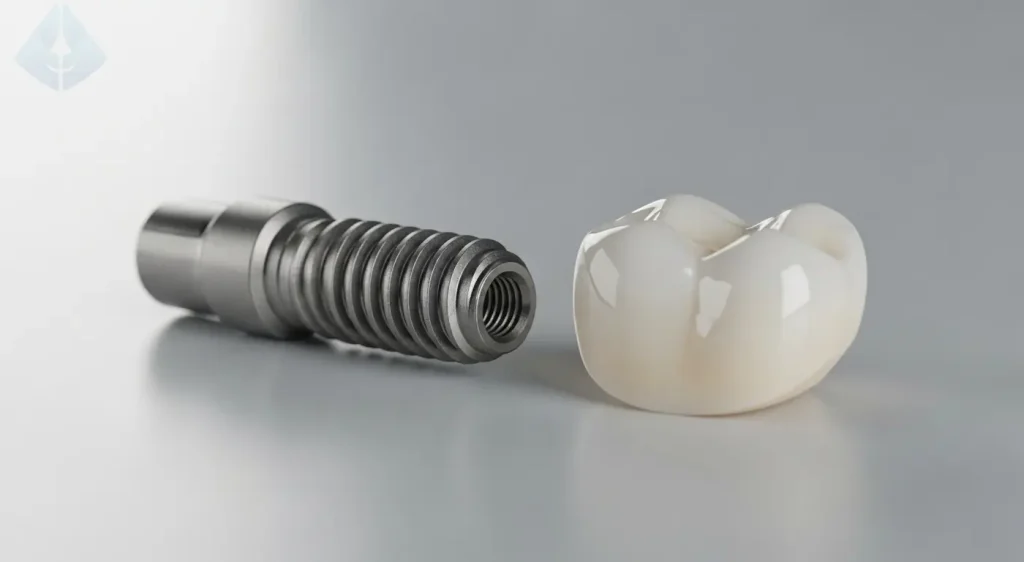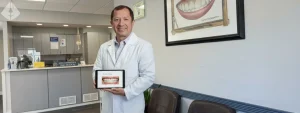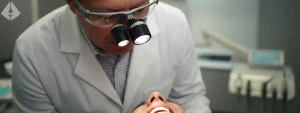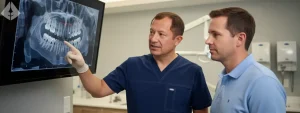Losing a tooth might seem like a minor inconvenience, an aesthetic issue you might choose to ignore. However, what begins as a simple gap in your smile often marks the start of a silent, cascading series of dental health problems. In fact, understanding the serious missing tooth consequences is the first step toward protecting your long-term health, confidence, and finances. At our Westfield, NJ clinic, internationally recognized cosmetic dentist Dr. Aristo Carranza emphasizes that replacing a missing tooth is not just about aesthetics—it’s about preserving the very foundation of your oral health.
Consequently, ignoring that gap is a gamble where the stakes get higher over time. Instead of its initial price, the true “cost” of a missing tooth emerges from the complex, expensive procedures needed years down the line to correct the damage from inaction. Therefore, this article will explore the domino effect of tooth loss and reveal why addressing it promptly is one of the most crucial investments you can make in yourself.
More Than Just a Gap: The Immediate Aesthetic Impact
Of course, the most immediate and noticeable consequence of a lost tooth is the visible space it leaves behind. This can profoundly affect your self-esteem, subsequently making you hesitant to smile freely or speak with confidence. Indeed, your smile is a cornerstone of your identity, and a gap can alter your facial symmetry and overall appearance. While this aesthetic concern is valid and significant, it’s merely the tip of the iceberg. Ultimately, you cannot see the most severe missing tooth consequences at first glance.
The Domino Effect: What Happens Beneath the Surface?
Your teeth work together as a complex, harmonious system. Consequently, when you lose one, this action compromises the entire structure, triggering a chain reaction of negative events that worsen over time.
The Silent Thief: Mandibular Bone Resorption Explained
One of the most critical and least understood effects of tooth loss is bone resorption. Your jawbone maintains its density and form because the roots of your teeth constantly stimulate it. Specifically, every time you chew, the root transmits tiny stresses to the bone, signaling it to remain strong. However, when a tooth is lost, that stimulation vanishes. As a result, the jawbone, much like a muscle that isn’t used, begins to atrophy or shrink in that area. This process, known as resorption, can lead to:
Changes in Facial Structure: As the bone diminishes, it can cause the surrounding facial muscles to sag, leading to a sunken, prematurely aged appearance.
Difficulty with Future Restorations: Additionally, significant bone loss makes placing a dental implant—the gold standard for tooth replacement—much more complicated. A bone graft procedure often becomes necessary to rebuild the jaw, adding significant cost and time to the treatment.
A Shift in Power: How Adjacent Teeth Migrate
A delicate balance holds your teeth in place, with each one supporting its neighbors. When a tooth is missing, however, this support system collapses. Subsequently, the adjacent teeth will naturally begin to drift and tilt into the empty space. Furthermore, the tooth in the opposing jaw, now lacking a partner to bite against, can start to “super-erupt” or grow out of its socket.
This migration leads to a host of new problems from missing teeth, including:
A Crooked Smile: The shifting creates new gaps and alignment issues throughout your mouth.
Increased Risk of Decay: Tilted teeth are much harder to clean effectively, thus creating new areas where plaque and bacteria can accumulate, leading to cavities and gum disease.
The Misalignment Cascade: Bite and Jaw Problems
As your teeth shift, the movement inevitably throws off your bite (occlusion). This, in turn, forces other teeth to handle biting pressures they weren’t designed for. Consequently, this can result in:
Uneven Wear and Tear: Your remaining teeth can wear down unevenly and prematurely, leading to chips, fractures, and the need for crowns or other restorations.
Chewing Difficulties: An imbalanced bite can make it difficult to chew food properly, potentially leading to digestive issues.
TMJ Disorders: Moreover, the strain on your jaw can lead to temporomandibular joint (TMJ) disorder, a painful condition characterized by jaw pain, headaches, and clicking or popping sounds.
The Financial Snowball: The True Long-Term Cost of Inaction
Many people delay replacing a tooth because of the perceived upfront cost. However, this is a financial fallacy. In reality, the cost of not replacing a tooth is almost always higher in the long run. This is because the secondary problems that develop require far more extensive and expensive treatments than a single tooth replacement.
Here is a comparison of addressing the problem now versus later:
| Problem from a Missing Tooth | Cost of a Timely Solution | Potential Future Treatment & Higher Costs |
| Initial Tooth Loss | Dental Implant or Bridge | The costs below are in addition to tooth replacement. |
| Bone Resorption | (Prevented by Implant) | Bone Grafting Surgery to rebuild the jaw. |
| Shifting & Tilting Teeth | (Prevented by Replacement) | Orthodontic Treatment (braces or clear aligners). |
| Bite Misalignment / TMJ | (Prevented by Replacement) | TMJ Therapy, multiple crowns, or full mouth reconstruction. |
| Increased Decay & Gum Disease | (Prevented by Proper Alignment) | Fillings, Root Canals, and Periodontal Treatment. |
As the table clearly shows, the long-term effects of tooth loss create a financial snowball. A single problem evolves into multiple, interconnected issues that then require a cascade of costly interventions.
Restore Your Smile and Health with Dr. Aristo Carranza in Westfield, NJ
The good news is that you can prevent all these severe missing tooth consequences. Specifically, modern cosmetic dentistry offers outstanding, permanent solutions that restore not only the appearance of your smile but also its critical function and health.
At our clinic, for instance, Dr. Aristo Carranza utilizes state-of-the-art technology and his renowned expertise to design personalized treatment plans. He typically recommends a dental implant as the premier solution, as it acts as an artificial tooth root. It is the only method that stimulates the jawbone to prevent bone resorption, while also keeping adjacent teeth perfectly in place. In other words, it looks, feels, and functions exactly like a natural tooth.
Ultimately, by choosing an expert like Dr. Carranza, you are not just filling a gap—you are investing in a comprehensive solution that safeguards your entire oral system. You are choosing a future of confident smiles, comfortable function, and freedom from the complex problems that haunt an untreated missing tooth.
Don’t Wait for the Dominoes to Fall
A missing tooth is far more than a cosmetic flaw; indeed, it is a ticking clock that silently compromises your oral health. The longer you wait, the more complex and costly the solution becomes.
Therefore, take control of your dental future. Prevent the cascade of negative consequences and invest in a solution that provides lifelong value. Contact the office of Dr. Aristo Carranza in Westfield, NJ, today to schedule your comprehensive consultation and discover how a beautiful, permanent tooth replacement can protect your smile and your health for years to come.

